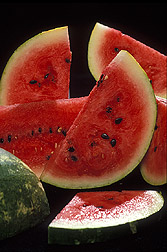This page has been archived and is being provided for reference purposes only. The page is no longer being updated, and therefore, links on the page may be invalid.
Read the magazine story to find out more. |
|
Grafting Watermelon Makes Firmer, Healthier Fruit
By Jim CoreJuly 1, 2005
Packaged, cut-up watermelon is convenient for consumers and represents a rapidly expanding market. But the fruit can quickly lose crispness when cut, presenting a challenge to the "fresh-cut" market that demands a firm, attractive fruit.
One way to meet this challenge is to graft watermelon tops onto gourd or squash rootstock, according to Benny Bruton, an Agricultural Research Service (ARS) plant pathologist with the agency's South Central Agricultural Research Laboratory in Lane, Okla. Bruton and his colleagues found that grafted watermelons are resistant to Fusarium wilt, a widespread and costly plant fungus.
Fruit from certain grafted plants was also at least 25 to 30 percent firmer and was resistant not only to Fusarium, but to many other soilborne pathogens, according to Bruton and cooperators Warren Roberts and Wayne Fish. Roberts is a horticulturalist with Oklahoma State University's Wes Watkins Agricultural Research and Extension Center in Lane, and Fish is an ARS biochemist at Lane.
Fusarium fungi live in the soil and attack plants at all stages of growth. Until now, watermelon growers in the United States have dealt with Fusarium-infested soil by treating with methyl bromide to kill the fungus, rotating the fields or growing partially resistant cultivars.
The U.S. watermelon industry did not embrace grafting previously because it was considered too expensive. However, the first two solutions to Fusarium wilt control are becoming less workable as land becomes less available for field rotation, and agricultural use of methyl bromide is being discontinued because of its negative impact on the ozone layer.
A number of watermelon cultivars are available that have varying resistance to Fusarium, but not to the degree of grafted watermelon, and not with the added benefit of fruit firmness that was found with grafting. Because of the improved fruit quality characteristics of grafted watermelon, they may eventually be targeted for the "fresh-cut" market.
Read more about the research in the July 2005 issue of Agricultural Research magazine.
ARS is the U.S. Department of Agriculture's chief scientific research agency.

